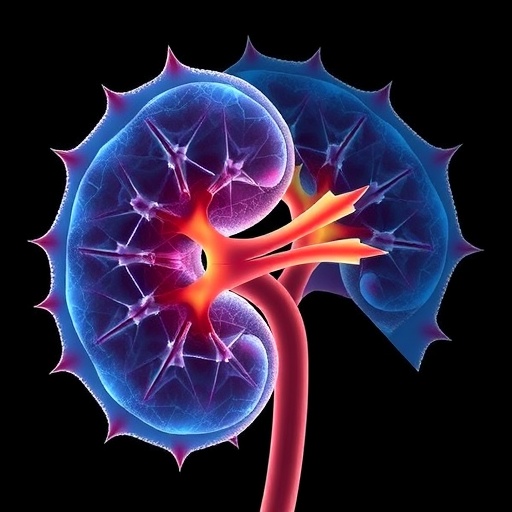In a landmark achievement that could profoundly impact the future of regenerative medicine, scientists at Kumamoto University have successfully engineered functional ureteral tissue in vitro using pluripotent stem cells. This pioneering work, led by Professor Ryuichi Nishinakamura and his team at the Institute of Molecular Embryology and Genetics, marks the first time a ureteral structure has been constructed entirely from stem cells. The breakthrough is poised to bridge a crucial gap in kidney organoid research, potentially paving the way toward the creation of fully transplantable kidneys capable of producing and excreting urine.
The ureter, a vital tubular conduit responsible for transporting urine from the kidneys to the bladder, has remained an elusive component in lab-grown kidney models. Despite advancements in kidney organoid technology, the absence of a functional ureter has long hindered the ability to replicate the full physiological complexity and functionality of the urinary system. The inability to simulate urine flow and drainage has presented a significant barrier to the clinical translation of kidney organoids for transplantation.
To overcome this challenge, the team devised a sophisticated protocol to induce the differentiation of ureteral stromal progenitor cells from pluripotent stem cells. Utilizing these stromal progenitors in conjunction with ureteral epithelial progenitor cells—sourced either from mouse embryos or induced from pluripotent stem cells themselves—they engineered three-dimensional organoids that spontaneously self-organize into layered ureteral structures. Remarkably, these organoids exhibit peristaltic contractions, mimicking the rhythmic movements essential for urine propulsion observed in vivo.
This self-organization into a functional, three-layered ureteral architecture comprising stromal, epithelial, and muscle-like layers indicates the organoids’ potential to recapitulate the structural and physiological properties of natural ureters. The researchers documented rhythmic contractions resembling those of native urine flow, a feature never before demonstrated in stem cell-derived ureteral constructs. This functional mimicry suggests that the engineered ureters are not merely structural replicas but possess dynamic capabilities fundamental to their biological role.
Beyond structural and functional replication, the study also ventured into modeling congenital ureteral anomalies by introducing mutations in the TBX18 gene—a transcription factor crucial for ureter development. Organoids derived from TBX18-mutated cells displayed impaired development and morphological abnormalities, thereby establishing a novel platform for investigating the genetic underpinnings of urinary tract malformations. This disease modeling capacity provides an invaluable tool for exploring the pathogenesis of congenital disorders and assessing potential therapeutic interventions.
Professor Nishinakamura emphasized the transformative implications of this research, noting that integrating these ureter organoids with existing kidney organoids may finally fulfill the longstanding goal of producing transplantable kidneys capable of actual urine production and excretion. This synergy paves the way for regenerative therapies that do not merely replace kidney tissue but restore the comprehensive function of the entire urinary tract.
The creation of a functional ureter from pluripotent stem cells is a testament to the remarkable advances in developmental biology and stem cell technology. By recapitulating embryonic developmental pathways, the research team succeeded in coaxing pluripotent cells to differentiate into specialized progenitor populations and self-assemble into complex organ architectures. This bottom-up approach mirrors natural ontogeny and contrasts with previous methods that often relied on exogenous scaffolds or artificial constructs.
The methodology underpinning this breakthrough involved the careful orchestration of signaling pathways and microenvironmental cues to direct stem cell fate. By manipulating molecular gradients and timing differentiation stages precisely, the team generated stromal progenitors marked by specific lineage markers, such as TBX18, that are essential for ureter development. Combining these cells with epithelial progenitors allowed for the establishment of key cell-cell interactions vital for tissue maturation and organoid formation.
Importantly, the engineered ureter organoids demonstrated essential functional characteristics, including concentric smooth muscle-like layers responsible for contractility and an epithelial lining competent for barrier function and urine transport. The differentiation and maturation of these cell layers were validated through histological analyses and gene expression profiling, confirming their resemblance to natural ureteral tissue.
This milestone not only enhances the sophistication of kidney organoid models but also elevates the potential for their clinical application. Currently, kidney organoids—while capable of mimicking nephron structures—lack the ability to process and excrete urine effectively due to the absence of a ureter. The addition of functional ureters closes this gap, potentially enabling fully integrated renal organoids that replicate whole-organ physiology necessary for transplantation.
The success achieved by Kumamoto University’s team is part of the broader “International Leading Research: Creating A Kidney” project, an ambitious global initiative funded by the Japan Society for the Promotion of Science (JSPS) and other leading agencies. This consortium unites researchers worldwide to push the boundaries of organoid science, regenerative therapies, and organ transplantation, with a mission to overcome current organ shortages and improve patient outcomes.
The implications of this research extend beyond transplantation medicine. The ureter organoid system provides an unprecedented in vitro model for studying urinary tract development, physiology, and pathology. This platform could enable high-throughput screening for nephrotoxic drugs, investigation of urinary tract infections, and exploration of mechanisms underlying urinary tract obstructions and other diseases that currently lack robust experimental models.
Looking forward, challenges remain in scaling these organoids for clinical use, integrating them into vascularized systems, and ensuring long-term viability and functionality post-transplantation. Nevertheless, this study constitutes a crucial first step by demonstrating the feasibility of generating functional ureteral tissue from pluripotent stem cells, setting the stage for future breakthroughs that may revolutionize kidney regenerative medicine.
The convergence of stem cell biology, organoid technology, and developmental genetics encapsulated in this research highlights an era of unprecedented potential for personalized and regenerative therapies. Through meticulous engineering of cellular components and microenvironments, the longstanding dream of bioengineered, fully functional, transplantable kidneys incorporating complex urinary tract structures edges closer to realization.
Subject of Research: Cells
Article Title: In vitro generation of a ureteral organoid from pluripotent stem cells
News Publication Date: 20-Jun-2025
References:
Ibi et al., Nature Communications, DOI: 10.1038/s41467-025-60693-6
Image Credits: Ibi et al.
Keywords: Kidney, Pluripotent stem cells, Stroma, Somatic cells, Mesoderm, Progenitor cells, Organoids, Epithelial cells, Urine




